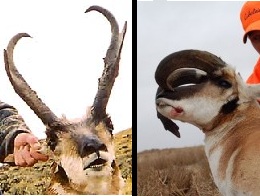I, personally, fancy non-typical antlers on anything that grows antlers…or horns for that matter. Something about the non-traditional wacky, growing-in-every-direction antlers gets my heart beating fast. I don’t care whether it’s a muley, whitetail, elk or antelope. Give me something non-typical!
On the other hand, I know people who would pass up a non-typical antlered or horned animal they were hunting in hopes of finding a traditional, symmetrical one. Although, I cannot relate to that admiration, when my hunting buddy is not even remotely interested in the same type of animal I am, trying to convince him to like what I like seems ridiculous on my part.
I did some research on what makes an animal grow non-typical antlers, and found some interesting information. Disease, low testosterone, female testosterone and leg injuries are all potential contributing factors to non-typical antlers in deer, according to ehow.com.
According to outdoorlife.com, “Genetic deformities typically occur on both antlers, whereas defects that affect only one antler aren’t likely to be genetic. Lack of brow tines among mature bucks, for example, appears to be genetically controlled.”
Interesting information,and I am not deterred. Whether non-typical antlers are formed from genetic abnormalities or from injury, I am still partial to them. I prefer to not have the “Stepford Wife” trophy mount on my wall. Give me the red-headed step child antlers any day!
What type do you prefer for your trophy mount?

Typical (L) vs. Non-Typical (R) Antelope